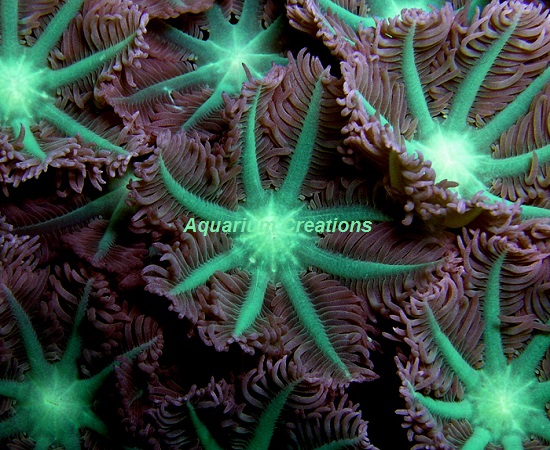Neon Green Clove Polyps,(Clavularia sp.) are a beautiful fast-growing soft coral that to many resemble Xenia. With soft feathery polyps that have neon green highlights, their base forms a tube that the stalk extends from. They grow to about 2 to 3 inches tall and the feathery polyps are about 1/2 to 3/4 inch in size. If they sense danger or are bothered the feathery polyps retract into the base of the coral making it look like purple bumps on the coral rock. Like all of our polyps they are aquacultured specimens, many generations removed from the original wild starter colonies.
Clove Polyps are also known as Eight-Tentacle Polyps, Fern Polyps, Glove Polyps, or Palm Tree Polyps. There are more than 40 members of clove polyps, the majority from the Indo-Pacific region. Fairly easy to maintain in the home aquarium, they naturally occur in many different morphological forms and colours, from beige, brown or purple-grey mats with cream, green, orange, purple, white, or yellow polyps. Often times the centre of the polyp is a contrasting colour to the tentacles, and the tentacles themselves can vary in thickness, but each polyp always possesses a distinct eight tentacles. Clove Polyps form clumps connected by root-like growths which connect to the substrate, called (stolons), supported by unfused sclerites, and from which tube-like calyces, 1/2 an inch to 2 inches tall, arise uniformly. The solitary polyps are autozooids.
Aggressiveness
They are a peaceful coral with the capability of being able to retract or deflate their polyps in response to a bothersome predator. They will not bother nearby corals since they do not have sweeper tentacles.
Waterflow
We recommend a moderate level of water flow.
Lighting
Clove Polyps require a moderate lighting level,(PAR 100-150), to maintain their color. T5's, Metal Halides, or LED's can all grow Daisy Polyps when the proper PAR levels are provided. We recommend a 14-20K color spectrum for best colouration of the coral.
Placement
Clove Polyps may be placed anywhere which provides the required water flow and lighting level.
Diet and Feeding
In captivity, the symbiotic algae zooxanthellae hosted within their bodies provide the majority of their nutritional requirements through photosynthesis. We also recommend weekly feeding's of micro-plankton or other reef foods designed for filter feeding invertebrates. Good choices include Marine Snow, Artemia nauplii, and rotifer's. If your lighting is not as strong as desired, the feeding's will be more important since they will not be developing as much zooxanthellae on their own. Increase feeding's to twice a week in that case. For continued good health, we recommend the addition of iodine and other trace elements to the water. To help provide food for all your corals we strongly suggest putting up a refugium for your reef system. Make sure it has at least a 4" sand bed. It really helps your coral do well since it naturally provides correct food for your corals.
|



